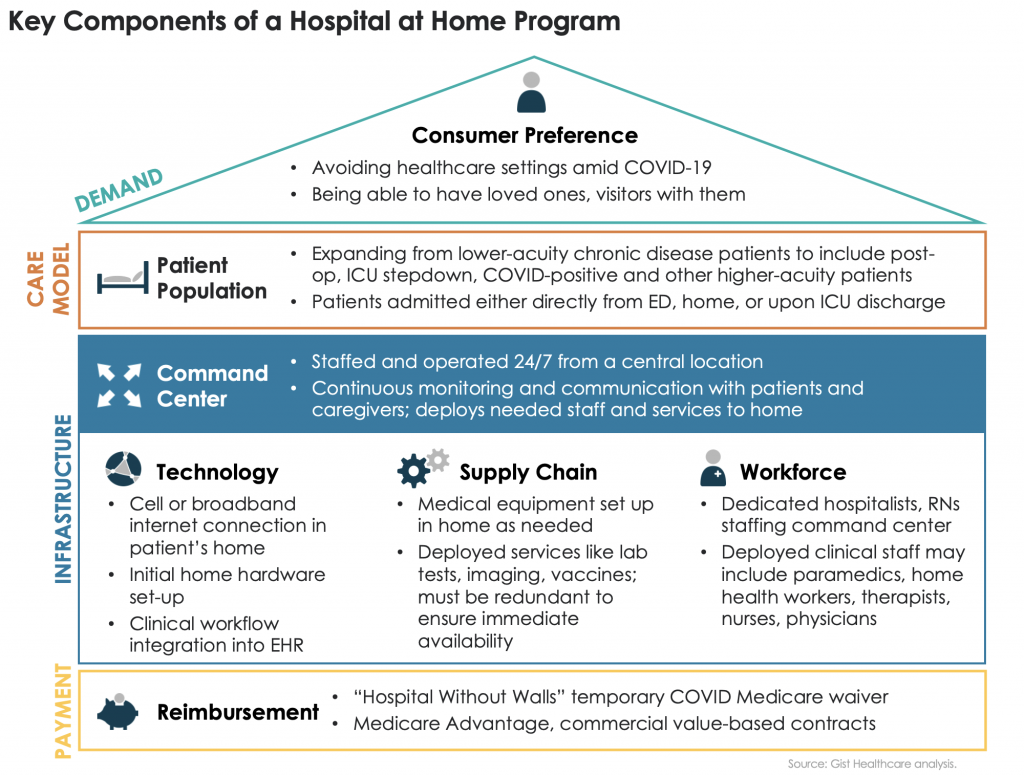
@ShahidNShah


The COVID-19 pandemic has highlighted the importance of delivering care outside of traditional hospital settings. Hospital-at-home programs have emerged as a viable option for patients who require acute care but would prefer to receive it in the comfort of their homes. Hospital-at-home programs can provide high-quality care while also reducing costs and freeing up hospital beds for patients who require more intensive care. Implementing hospital-at-home programs requires careful planning and coordination. Healthcare organizations must assess patient eligibility and ensure that patients have access to the necessary equipment and support. Effective communication between healthcare providers and patients is also essential to ensure that patients understand their treatment plan and can receive help if needed. Healthcare organizations must also establish protocols for managing emergencies and ensuring continuity of care. Hospital-at-home programs can be a beneficial option for patients and healthcare organizations, but they require careful planning and coordination to ensure their success.
As the healthcare industry continues to evolve, health plans must also adapt to support home-based care. Home-based care can provide patients with more personalized and convenient care while also reducing costs and improving outcomes. However, implementing home-based care requires significant coordination between healthcare providers, health plans, and patients. Health plans can support home-based care by offering coverage for telehealth services and other home-based care options. Health plans can also incentivize healthcare providers to offer home-based care by offering reimbursements for home visits and other home-based services. Health plans can also support patients by providing education and resources to help them manage their health at home. Adapting health plans to support home-based care can provide significant benefits for patients and healthcare organizations, but it requires collaboration and coordination across the healthcare industry.
The COVID-19 pandemic has accelerated the adoption of telehealth services, which offer patients the convenience of receiving medical care from the comfort of their homes. For telehealth services to be effective, patients must trust that they are reliable and secure. Healthcare organizations can build trust with patients by being transparent about their data privacy and security practices, educating patients about telehealth services, and training healthcare providers in the use of telehealth technology.
Transparency is key to building patients’ trust in telehealth services. Patients need to know how their data is collected, stored, and used, and healthcare organizations should clearly communicate their data privacy and security practices to patients. Creating an easily understandable privacy policy and explaining the telehealth service’s security measures can help build trust.
Patients must also be educated about how telehealth services work and the benefits they offer. Healthcare organizations should educate patients on how to use the telehealth services and the type of care they can receive through them. This can lead to increased adoption and usage of telehealth services.
Training healthcare providers in the use of telehealth technology is essential for building trust in telehealth services. Providers should be trained in best practices for telehealth consultations, ensuring patient privacy and security during telehealth sessions, and effective communication with patients through telehealth platforms. By establishing trust with patients, healthcare providers can provide the care patients need regardless of their location.
Hospital-at-home programs offer a patient-centered and cost-effective alternative to traditional hospital care. By providing acute care in the patient’s home, these programs can reduce hospital readmissions; improve patient outcomes, and lower costs. However, some healthcare providers are concerned about the quality of care and potential risks of providing care outside of a hospital setting. To address these concerns, healthcare organizations must prioritize patient safety, implement robust monitoring systems, and provide adequate training and support to healthcare providers.
Hospital-at-home programs have emerged as a promising alternative to traditional hospital care. These programs deliver acute hospital-level care to patients in their homes, offering several advantages for both patients and healthcare organizations. According to a Commonwealth Fund article, hospital-at-home programs can improve patient outcomes, lower costs, and enhance patient satisfaction.
One of the primary advantages of hospital-at-home programs is the reduction in hospital-acquired infections. Hospital-acquired infections are a significant concern in traditional hospital settings, and they can lead to extended hospital stays and increased healthcare costs. Hospital-at-home programs eliminate this risk, as patients are in a familiar and controlled environment.
Hospital-at-home programs can also reduce the length of hospital stays and help patients return to their normal lives more quickly. Traditional hospital stays often require patients to be away from their families and daily routines, which can be a significant source of stress. Hospital-at-home programs allow patients to receive care in the comfort of their own homes, reducing stress and promoting a faster recovery.
Furthermore, hospital-at-home programs can be cost-effective for healthcare organizations. They reduce the need for expensive hospital infrastructure and associated overhead costs. This can result in significant cost savings, particularly for organizations that serve a large number of patients.

Source: Is it Time for Hospital at Home?
While hospital-at-home programs offer many benefits, their implementation can be challenging. One of the main challenges is identifying patients who are suitable candidates for these programs. Not all patients are eligible for hospital-at-home programs, as they require access to certain resources and support systems that may not be available in all communities.
Additionally, some patients may be resistant to the idea of receiving medical care in their homes. Healthcare organizations must work to identify eligible patients and educate them about the potential benefits of hospital-at-home programs. This requires a collaborative effort between healthcare professionals and patients and their families to ensure that patients receive the best possible care.
Ensuring patient safety is another challenge associated with hospital-at-home programs. Patients who participate in these programs are often dealing with acute medical conditions that require close monitoring and intervention. Healthcare organizations must develop robust monitoring systems that can quickly identify and address any changes in patient status.
This includes ensuring that patients have access to necessary medical equipment and supplies, such as oxygen tanks and intravenous medications. Additionally, healthcare organizations must ensure that patients have access to medical professionals who can respond quickly to any emergencies that may arise. Prioritizing patient safety is crucial to the success of hospital-at-home programs and requires a commitment to ongoing monitoring and evaluation.
Hospital-at-home programs have the potential to offer several advantages for patients and healthcare organizations. They can improve patient outcomes, lower costs, and enhance patient satisfaction. However, their implementation requires careful planning and coordination to ensure that eligible patients receive the best possible care. Healthcare organizations must prioritize patient safety and develop robust monitoring systems to ensure that patients receive timely and appropriate care. With careful planning and ongoing evaluation, hospital-at-home programs can be a valuable addition to healthcare delivery systems.
Hospital-at-home programs have become increasingly popular as they provide an opportunity for patients to receive quality care in the comfort of their homes. However, ensuring patient safety remains a key challenge. One way to address this challenge is by investing in robust monitoring systems that can quickly identify any changes in patient status and alert medical professionals to potential issues.
According to the Commonwealth Fund article, effective monitoring systems for hospital-at-home programs should include regular check-ins from medical professionals, real-time monitoring of vital signs and other key indicators, and rapid-response systems that can quickly dispatch medical personnel in the event of an emergency. It is also essential that these systems integrate with electronic health record (EHR) systems, allowing medical professionals to access patient data in real-time and make informed decisions about patient care. By investing in effective monitoring systems, healthcare organizations can help ensure the safety and well-being of patients participating in hospital-at-home programs.
The COVID-19 pandemic has accelerated the shift towards home-based care in healthcare. This shift requires health plans to adapt their policies and practices to meet the changing needs of patients. Health plans must focus on several key areas, including telehealth services, home-based care, and data security. They must also ensure that they have adequate provider networks and reimbursement structures in place to support home-based care.
Home-based care has several advantages, including improved patient outcomes, lower costs, and increased patient satisfaction. Advances in telehealth technology have made it easier for healthcare providers to deliver high-quality care to patients in their homes. As a result, the shift towards home-based care has been accelerated by the COVID-19 pandemic.
To support the shift towards home-based care, health plans must ensure that patients have access to telehealth services, including remote monitoring and virtual visits, to receive care in their homes. Health plans must also ensure that healthcare providers are trained and equipped to deliver care via telehealth services. This requires changes to the reimbursement structures of health plans, which may require collaboration with regulatory bodies and healthcare providers.
Telehealth services must be a priority in health plans to support home-based care. Prioritizing telehealth services in health plans can help improve patient outcomes, reduce costs, and increase patient satisfaction.
Healthcare providers must be trained and equipped to deliver care to patients in their homes. Provider networks must be expanded to include healthcare providers who can deliver care to patients in their homes. Reimbursement structures must also be adapted to ensure that healthcare providers are reimbursed for providing care to patients in their homes. This requires collaboration between health plans, regulatory bodies, and healthcare providers to ensure that patients have access to high-quality care in their homes.
The shift towards home-based care in healthcare has accelerated due to the COVID-19 pandemic. To ensure patient safety, healthcare organizations must invest in robust monitoring systems for hospital-at-home programs. Health plans must adapt their policies and practices to support home-based care by prioritizing telehealth services, expanding provider networks, and adapting reimbursement structures. Collaboration between health plans, regulatory bodies, and healthcare providers is essential to ensure that patients have access to high-quality care in their homes.
Ensuring patient data security is crucial in any healthcare setting, including home-based care. Healthcare innovators and technology procurement officers at hospitals and health systems can take action to address patient data security in home-based care. To keep patient data secure in home-based care, healthcare innovators and technology officers can implement several technologies. These include authentication mechanisms, encryption protocols for data in transit and at rest, regular data backups, secure remote access, auditing and monitoring technologies, and compliance with relevant regulations like HIPAA and GDPR. Healthcare organizations that are seeking technological solutions to improve patient data security and overall care quality can consider the following options:
CareVoyant is a software platform for home care agencies that offers a range of functions to streamline workflow, meet regulatory requirements, and enhance operational efficiency. It provides benefits such as managing multiple lines of service efficiently, scalability, intelligent scheduling, simplified billing, real-time reporting, and effective communication tools. CareVoyant is committed to continuous innovation, offering a partnership that supports home care agencies’ mission to provide high-quality care.
Anidra offers three medical monitoring solutions that provide real-time vital sign monitoring from anywhere in the world. The Remote Monitoring and Ward Telemetry Solutions are designed for doctors to monitor patients in real-time, while the Home Care Solution allows patients to stream vital signs to healthcare providers or family members. These solutions improve patient outcomes and overall healthcare management.
Alora Home Health Software simplifies and streamlines home health care management while ensuring compliance with various payer requirements. The software offers features such as electronic documentation, mobile accessibility, and COVID-19 screening, along with the ability to handle billing for all payers and track caregiver credentials.
Connecting innovation decision makers to authoritative information, institutions, people and insights.
Medigy accurately delivers healthcare and technology information, news and insight from around the world.
Medigy surfaces the world's best crowdsourced health tech offerings with social interactions and peer reviews.
© 2025 Netspective Foundation, Inc. All Rights Reserved.
Built on Jul 2, 2025 at 4:28am